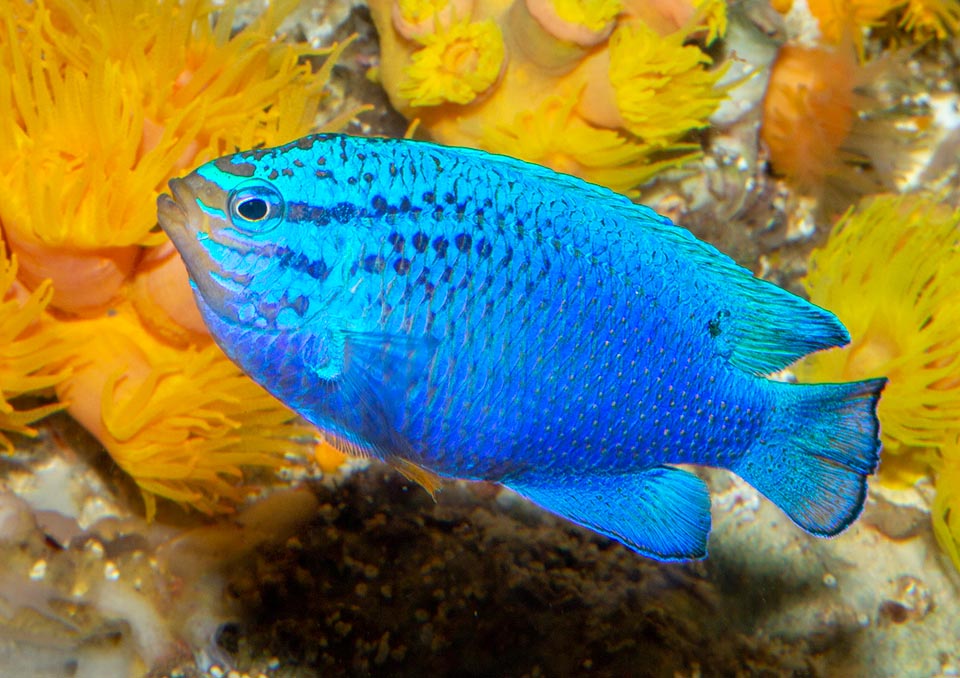Family : Pomacentridae

Text © Giuseppe Mazza

English translation by Mario Beltramini

Male of Chrysiptera cyanea in defensive posture. The tip of the snout, the chin, the pelvic and the caudal fins are colouring of yellow © Giuseppe Mazza
The Chrysiptera cyanea (Quoy & Gaimard, 1825), known in Italy as Blue demoiselle or Sapphire devil taking the English name of “Blue devil”, belongs to the class of the Actinopterygii, the ray-finned fishes, to the order of the Perciformes and to the family of the Pomacentridae that counts 29 genera and more than 400 species among which the well known clownfishes and the damselfishes.
The name of the genus Chrysiptera, comes from the Greek “χρυσός” (khrusos) = gold and “πτερόν” = wing,fin, due to the golden first caudal fin of the males. The name of the species cyanea also comes from the Greek “κύᾰνος” (cýanos) = deep blue, with obvious reference to the livery.
Zoogeography
The Chrysiptera cyanea has a vast distribution along the coasts of the eastern Indian Ocean and the western Pacific. Indicatively, we find it in India, Thailand, Vietnam, Indonesia, Philippines, Taiwan, RyuKyu Islands and south of Japan, then, in Oceania in Palau, the Northern Marianas, in Papua New Guinea, Australia, Micronesia, Solomon Islands, Vanuatu Islands, New Claedonia, Fiji Islands and Samoa.

The females, smaller than the males, have the caudal fin translucent, like the end of the dorsal and of the anal fins, and a typical black spot, visible also in the young fish, at the base of the dorsal fin, close to the caudal peduncle © Giuseppe Mazza
Ecology-Habitat
It lives in very shallow waters, as never goes down beyond the 10 m of depth. It loves the calm lagoons with rocks and madreporic formations rich of hideaways.
Morphophysiology
The males of Chrysiptera cyanea may reach the 8,5 cm, but the females, smaller, do not exceed the 6,5 cm.
The body is flattened laterally.
The head has a small protractile mouth, armed with tiny thin and sharp teeth.
The dorsal fin, erectile when the fish feels menaced, has 13 spiny rays and 12-13 soft, whilst the anal has 2 spiny rays and 13-14 soft. The pectoral ones count 15-17 rays and are unarmed as well as the pelvic.
Most of the body is blue electric with splendid iridescences like in many species of the genus Chrysiptera, but the livery displays an evident sexual dimorphism.
The females and the juveniles have a characteristic black spot at the base of the dorsal fin, close to the caudal peduncle. Moreover, the terminal part of the fins is translucent, whilst in the males the dorsal and the anal are blue and the great caudal fin is yellow or orange, like the tip of the snout, the chinstrip and the pelvic fins.
Twinklings and colour combinations that can distract for a moment the predators while the fish finds shelter in a ravine. They are very fast fishes, so much that he who wants to fish it out in a small home aquarium is almost obliged to disassemble the aquarium in order to succeed.
Ethology-Reproductive Biology
The Blue demoiselle is a diurnal species that often swims in small schools formed by one male, several females and some young. It nourishes of zooplankton, small crustaceans and algae.
The eggs, spawned in hundreds by the female on duty, are glued to the bottom, and the male, as usual for the fishes belonging to this genus, surveys them until the hatch oxygenating them with the movement of the fins in order to avoid the onset of molds.

Very fast, ready to hide among the madrepores spikes if it sees a predator, is active during the day, eating zooplankton, tiny crustaceans and algae © Giuseppe Mazza
The Chrysiptera cyanea is a fish that well adapts to the life in captivity. Easy to feed and moreover little expensive it is frequent also in the small home aquaria; but as the vulgar name of Sapphire devil suggests, it can show very aggressive towards the companions of pool.
It is to be introduced last, when the other fishes have already made a territory, because if it is the first guest of the aquarium, possibly used as a guinea pig seen that it stands among the most robust and least expensive marine fishes of the market, it will consider the habitat as all belonging to it, thus attacking repeatedly and without any pity the new incomers, already stunned and weakened by the movement.
Even if present in all the shops of marine aquaria, sold for a few pennies in the web, the Chrysiptera cyanea its not nowadays (2020) an endangered species.

The eggs are glued to the bottom, surveyed and aerated by the male’s fin till the hatching. It stands among the aquarium marine fishes easiest to feed and least dear © Giuseppe Mazza
The populations decimated by the events can double their members in less than 15 months and the fishing vulnerability index marks only 10 on a scale of 100.
Since 2021, Chrysiptera cyanea has been listed as “LC, Least Concern” in the IUCN Red List of endangered species.
Synonyms
Glyphisodon cyaneus Quoy & Gaimard, 1825; Abudefduf cyaneus (Quoy & Gaimard, 1825); Cbrysiptera cyaneus (Quoy & Gaimard, 1825); Glyphidodontops cyaneus (Quoy & Gaimard, 1825); Glyphisodon uniocellatus Quoy & Gaimard, 1825; Abudefduf uniocellatus (Quoy & Gaimard, 1825); Glyphisodon azureus Cuvier, 1830; Chrysiptera gaimardi (Swainson, 1839); Glyphidodon assimilis Günther, 1862; Abudefduf assimilis (Günther, 1862); Abudefduf turchesius Jordan & Seale, 1907; Abudefduf sapphirus Jordan & Richardson, 1908; Glyphisodon hedleyi Whitley, 1927; Chrysiptera punctatoperculare Fowler, 1946.
→ For general information about FISH please click here.
→ For general information about BONY FISH please click here
→ For general information about CARTILAGINOUS FISH please click here.
→ To appreciate the BIODIVERSITY of BONY FISH please click here.
→ To appreciate the BIODIVERSITY of CARTILAGINOUS FISH please click here.
